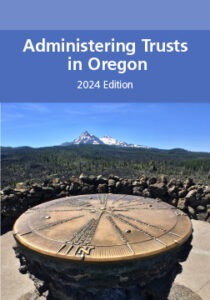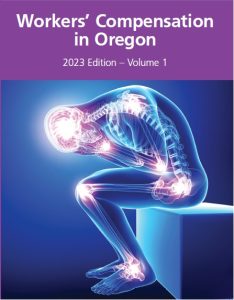 The fourth edition of Administering Trusts in Oregon is now available for preorder, shipping before the end of April! This new edition addresses changes to the law of trusts since the third edition was released in 2018.
The fourth edition of Administering Trusts in Oregon is now available for preorder, shipping before the end of April! This new edition addresses changes to the law of trusts since the third edition was released in 2018.
Featuring an all-new, portable 7″ x 10″ perfect-bound format, this comprehensive guide offers invaluable insights into the nuances of trust administration in Oregon. In addition, all references to the Uniform Trust Code Commentary now include pinpoint refences to the Legal Publications recent edition of Oregon Probate Code and Uniform Trust Code with UTC Commentary, which is also available for purchase.
Publication History
When Administering Trusts in Oregon was first published in 1995, the law of trust administration in Oregon was relatively unregulated by statute. The enactment of the Oregon Uniform Trust Code in 2005 made changes to and codified the law regarding administering trusts in Oregon, and so the 2007 edition was released to reflect changes to trust law brought about by the enactment of the UTC, including significant changes with regard to modifying or terminating a trust. Since then there have been changes in the rules regarding the trustees’ duties to inform and report, nonjudicial modifications, exercise of powers, and other technical corrections. The third edition of Administering Trusts in Oregon addressed these subsequent developments to trust law in Oregon.
Building on a Firm Foundation
With in-depth discussions of special-needs, charitable, and pet trusts, as well as spendthrift clauses and tax-implications of various types of trusts, this publication is an indispensable resource for attorneys seeking to expand their expertise in trust administration or to deepen their understanding of Oregon trust laws. The first three editions laid a firm foundation of material organized in a logical and comprehensive fashion.
This fourth edition addresses statutory and relevant case law updates that have occurred since the third edition in 2018. It includes new material discussing stewardship trusts and tenancy-by-the-entirety property in revocable trusts.
Why This Book Is Important
Lawyers often use trusts as an estate planning tool, and trusts are frequently administered by individual trustees. Administering Trusts in Oregon offers practical guidance to the lawyer who is counseling the trustee concerning the trustee’s rights and responsibilities in the trust administration process. In general, the book focuses on the individual trustee rather than the corporate trustee, and includes discussion of the trustee’s responsibilities to beneficiaries, settlors, and government entities.
The combined resources of Administering Trusts in Oregon and Oregon Probate Code and Uniform Trust Code with UTC Commentary will streamline your research and enhance your practice in this important area of law.
 The uniform jury instructions committees are charged with the task of developing uniform jury instructions for use in civil and criminal trials. They must also promote better coordination of activities between the two committees to insure a uniform approach to judicial instructions to juries. They continually update existing jury instructions to comply with case law, legislation, and useful suggestions from sections and the legal community, as well as raft instructions in plain language maintaining the goals of clarity and accuracy.
The uniform jury instructions committees are charged with the task of developing uniform jury instructions for use in civil and criminal trials. They must also promote better coordination of activities between the two committees to insure a uniform approach to judicial instructions to juries. They continually update existing jury instructions to comply with case law, legislation, and useful suggestions from sections and the legal community, as well as raft instructions in plain language maintaining the goals of clarity and accuracy. The first revision of this important publication since 2008, the 2023 edition of Workers’ Compensation in Oregon has been reorganized, updated with new case law and statutes, and includes three brand new chapters. The
The first revision of this important publication since 2008, the 2023 edition of Workers’ Compensation in Oregon has been reorganized, updated with new case law and statutes, and includes three brand new chapters. The  The ninth edition of Criminal Law in Oregon incorporates new material on sentencing and a variety of other topics in light of major court decisions and new legislation. This deskbook is essential for Oregon lawyers who practice criminal law. Topics covered in this comprehensive resource range from search and seizure to postconviction proceedings, plus a chapter on victims’ rights. Drawing on the wisdom of the experts in criminal law in Oregon, this book will save you time and resources. In addition to serving as the chief reference guide on criminal law for Oregon judges, defense lawyers, and prosecutors, Criminal Law in Oregon is also an invaluable resource for civil practitioners who handle the occasional criminal law case.
The ninth edition of Criminal Law in Oregon incorporates new material on sentencing and a variety of other topics in light of major court decisions and new legislation. This deskbook is essential for Oregon lawyers who practice criminal law. Topics covered in this comprehensive resource range from search and seizure to postconviction proceedings, plus a chapter on victims’ rights. Drawing on the wisdom of the experts in criminal law in Oregon, this book will save you time and resources. In addition to serving as the chief reference guide on criminal law for Oregon judges, defense lawyers, and prosecutors, Criminal Law in Oregon is also an invaluable resource for civil practitioners who handle the occasional criminal law case.  Most lawyer-client disputes involve fees. A clear, written agreement between lawyer and client can help prevent misunderstandings, fee disputes, and malpractice claims. The fifth edition of Fee Agreement Compendium is an essential practice tool that covers important information Oregon lawyers need regarding ethics issues, billing costs, credit issues, retainer letters, and IOLTA. In addition to the entire volume being available at our
Most lawyer-client disputes involve fees. A clear, written agreement between lawyer and client can help prevent misunderstandings, fee disputes, and malpractice claims. The fifth edition of Fee Agreement Compendium is an essential practice tool that covers important information Oregon lawyers need regarding ethics issues, billing costs, credit issues, retainer letters, and IOLTA. In addition to the entire volume being available at our  eChapters between November 10-11, 2022, using Coupon Code “
eChapters between November 10-11, 2022, using Coupon Code “